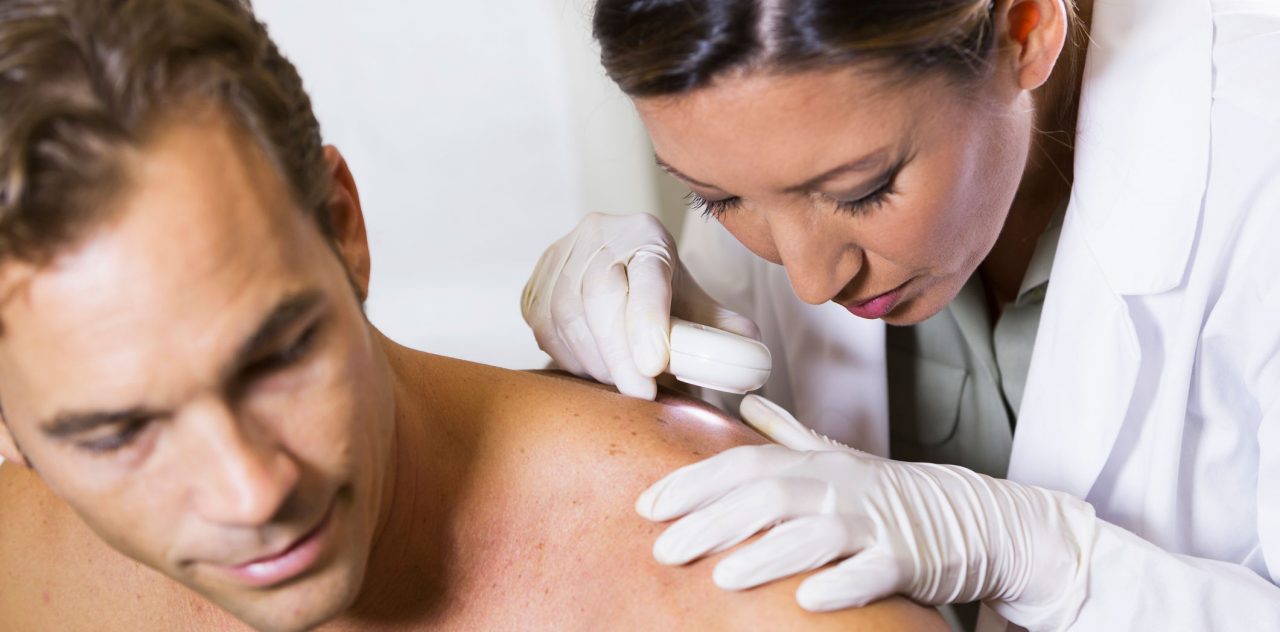Skin Cancer Symptoms

Knowing what skin cancer symptoms to look for, you can catch skin cancer early, get the right treatment, and prevent illness and death.
Skin cancer occurs when skin cells begin to grow abnormally, often because of overexposure to ultraviolet light or frequent sunburn. According to the Skin Cancer Foundation, it is the most common form of cancer in the United States, with millions of new cases diagnosed each year.
There are multiple types of skin cancer, and each has its own distinct appearance. Know what skin cancer symptoms to look for so you can receive early treatment and prevent prolonged illness and even death.
YOU MIGHT ALSO LIKE: Skin Cancer Facts
Skin cancer symptoms
Actinic keratosis
Actinic keratosis is a precancerous growth of the skin. If left untreated, it can eventually develop into cancer.
Symptoms of actinic keratosis include rough, dry, scaly patches of skin, some of which can be felt but difficult to see unless with a magnifying glass. The patches may feel painful when touched, become red or inflamed, itch, or burn. They may disappear spontaneously, with your skin becoming smooth again, before reappearing days or weeks later.
Actinic keratosis often appears on areas exposed to the sun, such as your arms, shoulder, and hands. It can also develop on your ears, forehead, and neck. According to one study, people with light skin are more susceptible to actinic keratosis, though it can develop on any color of skin.
Squamous cell carcinoma
Many studies have found that, if left untreated, actinic keratosis can develop into squamous cell carcinoma, a deadly skin cancer that causes thousands of preventable deaths each year in the United States alone.
Squamous cell carcinoma, according to the Cancer Treatment Centers of America, often develops as a rough lump on the skin. Other symptoms of skin cancer include reddish, scaly patches that look like a rash but do not heal. Squamous cell carcinoma can develop anywhere on your body but is most often found on your head, neck, hands, shoulders, and arms.
Basal cell carcinoma
Actinic keratosis can also develop into basal cell carcinoma, the most common skin cancer. Basal cell carcinoma often develops after frequent, unprotected sun exposure. It is also common among people who use tanning beds.
It is possible for basal cell carcinoma to grow anywhere on your body, but it frequently develops on your head, face, neck, and arms. A 2010 study found that basal cell carcinoma on your ear is particularly dangerous.
Symptoms of basal cell carcinoma, according the Skin Cancer Foundation, often resemble eczema or psoriasis. These include open sores that do not heal permanently, red patches, flaking skin, pink growths, or spots that look like unexplained scars. Basal cell carcinoma can also present as a shiny bump that is white, pink, red, or even dark brown, which can sometimes be mistaken for a regular mole.
YOU MIGHT ALSO LIKE: Why Tanning Beds Are Bad for You
Melanoma
Melanoma is the deadliest form of skin cancer. In 2013, melanoma alone caused over 9,000 deaths in the United States.
Melanoma symptoms usually appear in the form of a mole or a dark spot on your skin. These spots may appear suddenly or look very different from other moles that you have. Normal moles can also develop into melanomas after overexposure to the sun or overuse of tanning beds.
For symptoms of this skin cancer, the Centers for Disease Control and Prevention (CDC) recommends looking for one or more of the ABCDEs of melanoma:
- Asymmetry: one half of the mole is not symmetrical to the other.
- Border: the border is rough, irregular, or jagged.
- Color: the color is uneven and may contain multiple shades of black, brown, white, pink, or red.
- Diameter: the spot is larger than 6 millimeters across, about the size of a pencil eraser.
- Evolving: the color, size, or shape has changed.
Some melanomas, the American Cancer Society warns, may show symptoms other than the ABCDEs. These warning signs may include sores that don’t heal, redness or swelling beyond the border of a mole, new lumps or bumps on your skin, scaliness, oozing patches, or sudden tenderness or soreness of the skin.
Preventing skin cancer
To minimize your risk of developing skin cancer, the CDC advises avoiding overexposure to ultraviolet light year-round, not just during the summer. You can do this by wearing clothing that protects you from the sun, using sunscreen every day, wearing a hat and sunglasses outdoors, and avoiding indoor tanning.
If you are unsure whether spots on your skin might be signs of skin cancer, the American Cancer Society provides an online gallery of images of different skin cancers. If you have growths or changes in your skin that resemble any of the pictures in the gallery, talk to your doctor immediately to have the area examined.
It’s also important to remember that anyone can develop skin cancer symptoms, as most skin cancer appears when you’re older from overexposure in your youth. No matter your age or skin color, you should protect yourself from too much sun exposure and schedule regular visits to a dermatologist.
Updated:
March 18, 2020
Reviewed By:
Christopher Nystuen, MD, MBA